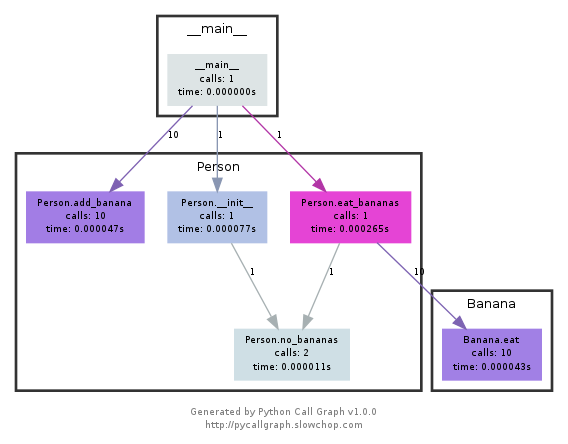Have a look at timeit, the python profiler and pycallgraph. Also make sure to have a look at the comment below by nikicc mentioning “SnakeViz“. It gives you yet another visualisation of profiling data which can be helpful.
timeit
def test():
"""Stupid test function"""
lst = []
for i in range(100):
lst.append(i)
if __name__ == '__main__':
import timeit
print(timeit.timeit("test()", setup="from __main__ import test"))
# For Python>=3.5 one can also write:
print(timeit.timeit("test()", globals=locals()))
Essentially, you can pass it python code as a string parameter, and it will run in the specified amount of times and prints the execution time. The important bits from the docs:
timeit.timeit(stmt='pass', setup='pass', timer=<default timer>, number=1000000, globals=None)Create aTimerinstance with the given statement, setup code and timer function and run itstimeitmethod with number executions. The optional globals argument specifies a namespace in which to execute the code.
… and:
Timer.timeit(number=1000000)Time number executions of the main statement. This executes the setup statement once, and then returns the time it takes to execute the main statement a number of times, measured in seconds as a float. The argument is the number of times through the loop, defaulting to one million. The main statement, the setup statement and the timer function to be used are passed to the constructor.Note: By default,
timeittemporarily turns offgarbage collectionduring the timing. The advantage of this approach is that it makes independent timings more comparable. This disadvantage is that GC may be an important component of the performance of the function being measured. If so, GC can be re-enabled as the first statement in the setup string. For example:
timeit.Timer('for i in xrange(10): oct(i)', 'gc.enable()').timeit()
Profiling
Profiling will give you a much more detailed idea about what’s going on. Here’s the “instant example” from the official docs:
import cProfile
import re
cProfile.run('re.compile("foo|bar")')
Which will give you:
197 function calls (192 primitive calls) in 0.002 seconds
Ordered by: standard name
ncalls tottime percall cumtime percall filename:lineno(function)
1 0.000 0.000 0.001 0.001 <string>:1(<module>)
1 0.000 0.000 0.001 0.001 re.py:212(compile)
1 0.000 0.000 0.001 0.001 re.py:268(_compile)
1 0.000 0.000 0.000 0.000 sre_compile.py:172(_compile_charset)
1 0.000 0.000 0.000 0.000 sre_compile.py:201(_optimize_charset)
4 0.000 0.000 0.000 0.000 sre_compile.py:25(_identityfunction)
3/1 0.000 0.000 0.000 0.000 sre_compile.py:33(_compile)
Both of these modules should give you an idea about where to look for bottlenecks.
Also, to get to grips with the output of profile, have a look at this post
pycallgraph
NOTE pycallgraph has been officially abandoned since Feb. 2018. As of Dec. 2020 it was still working on Python 3.6 though. As long as there are no core changes in how python exposes the profiling API it should remain a helpful tool though.
This module uses graphviz to create callgraphs like the following:

You can easily see which paths used up the most time by colour. You can either create them using the pycallgraph API, or using a packaged script:
pycallgraph graphviz -- ./mypythonscript.py
The overhead is quite considerable though. So for already long-running processes, creating the graph can take some time.
